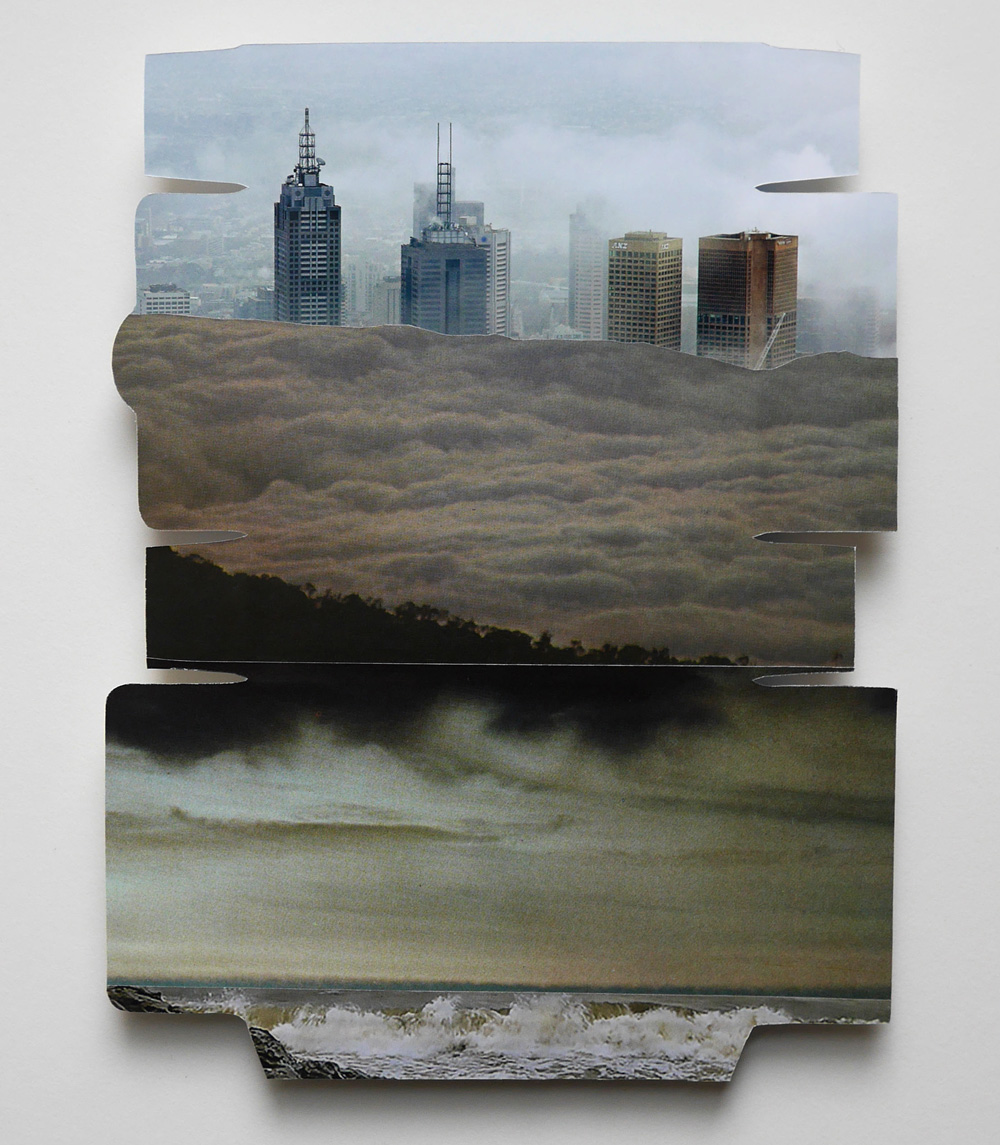
8.25″x6.25″; paper collage on waterproof bandage box; 2025. Courtesy of the artist.
RESIDENCY UPDATE
Collage the Planet: Trash as Material
A five-day, in-person collage artist residency at Kolaj Institute in New Orleans
Virtual Sessions: 11 and 15 October 2025
In Person: 20-24 October 2025
You can call it refuse or detritus or reclaimed materials or recycling or you can call it what it is, Trash. In collage, materials are never neutral. From how they are sourced to how they are used, the material a collage is made of shapes the story and experience of the artwork. During the “Collage the Planet: Trash as Material Artist Residency,” artists develop a practice of using trash as materials and make artwork for an exhibition at Kolaj Institute Gallery in New Orleans.
PROSPECTUS
The premise of the “Collage the Planet: Trash as Material Artist Residency” is that science has the capacity to tell us how to care for the planet, but those solutions are meaningless if humanity doesn’t care enough to evolve and change. Art is a unique technology that can distill complexity into simple human gestures that, when experienced, facilitate a deeper understanding of our world. In short, art can be a tool for caring. What role can artists play in sorting through the complex social, political, and economic dynamics that shape our discourse around the environment and leave us feeling confused and powerless? How do we sort through such complexity and develop an understanding for ourselves of what an ethical and healthy relationship with the natural world could be? What is the relationship between our individual choices and the systemic change needed to bring humanity’s relationship with the natural world into harmony? How do we move beyond rhetoric, cliche, and performative actions and towards meaningful change?
In this five-day, in-person residency, collage artists create work that explores environmentalism in art and make artwork that contributes to a broader dialogue on sustainability and ecological consciousness. Residents reflect on the balance between human activity and the environment and explore strategies to draw attention to issues such as climate change, biodiversity loss, and the impact of industrialization on our planet. This residency is particularly important to New Orleans, a city deeply connected to its natural surroundings and witness to ecological challenges and natural disasters that have left indelible marks on its landscape and community
GUEST SPEAKERS
Jill Stoll‘s Consumer Cloth Project asks, “How can we reconcile our addiction to consumerism and be safekeepers of our planet at the same time?” Stoll collects cardboard waste from “bodegas and restaurant dumpsters”, trolls “the neighborhood on garbage days”, and processes this material into strips which she weaves into artworks on an improvised loom of push pins, binder clips, and glue. During the residency, Stoll speaks about her project and her practice.
Artists visit Erin Genrich, Environmental Education Coordinator at The Green Project. Since 1994, the organization has promoted “a culture of creative reuse by diverting usable materials from landfills and cultivating a respect for their value.” They operate a salvage store and paint recycling program in the Bywater. They wrote, “By selling used and teaching about reuse, we are able to provide affordable materials to the community, host low-cost and free workshops, keep usable goods out of the landfill and nearby waterways, preserve historic architectural pieces and educate residents about environmental issues.” Genrich leads a tour of their site and speaks about the work of The Green Project. Together, artists explore ideas about how to use the materials on hand.
Ric Kasini Kadour presents an international, historic survey of artists that used trash in their work, from German Dadaist Kurt Schwitters to Brazilian artist Vik Muniz to Ghanaian artist Serge Attukwei Clottey, and speaks about how materials are never neutral in collage. Kadour also presents an overview of Kolaj Institute’s Politics in Collage project and shares examples of how other artists have made work that spoke to environmental concerns. As the project curator, Kadour guides artists through a process of building context for their artwork that supports its diffusion and ultimately its engagement with viewers.
OUTCOME
The goal of this residency is to support collage artists as they adapt their artist practice to speak to the complexities of environmental issues and contribute to a broader dialogue on sustainability and ecological consciousness.” During the residency, artists consider how elements of their practice (research & play, process, making, finishing, diffusion, and impact & engagement) can be adapted.
At the end of the residency, artists will be invited to submit artwork to the exhibition “Collage the Planet: Trash as Material”, 25 October to 29 November 2025, at Kolaj Institute Gallery in New Orleans.
The exhibition and artist residency, “Collage the Planet: Trash as Material” is part of Kolaj Institute’s project, Politics in Collage, a series of residencies, publications, discussions, and exhibitions examining complex socio-political issues that contemporary society is contending with, in order to spark meaningful dialogue and inspire deeper engagement.
PARTICIPATING ARTISTS
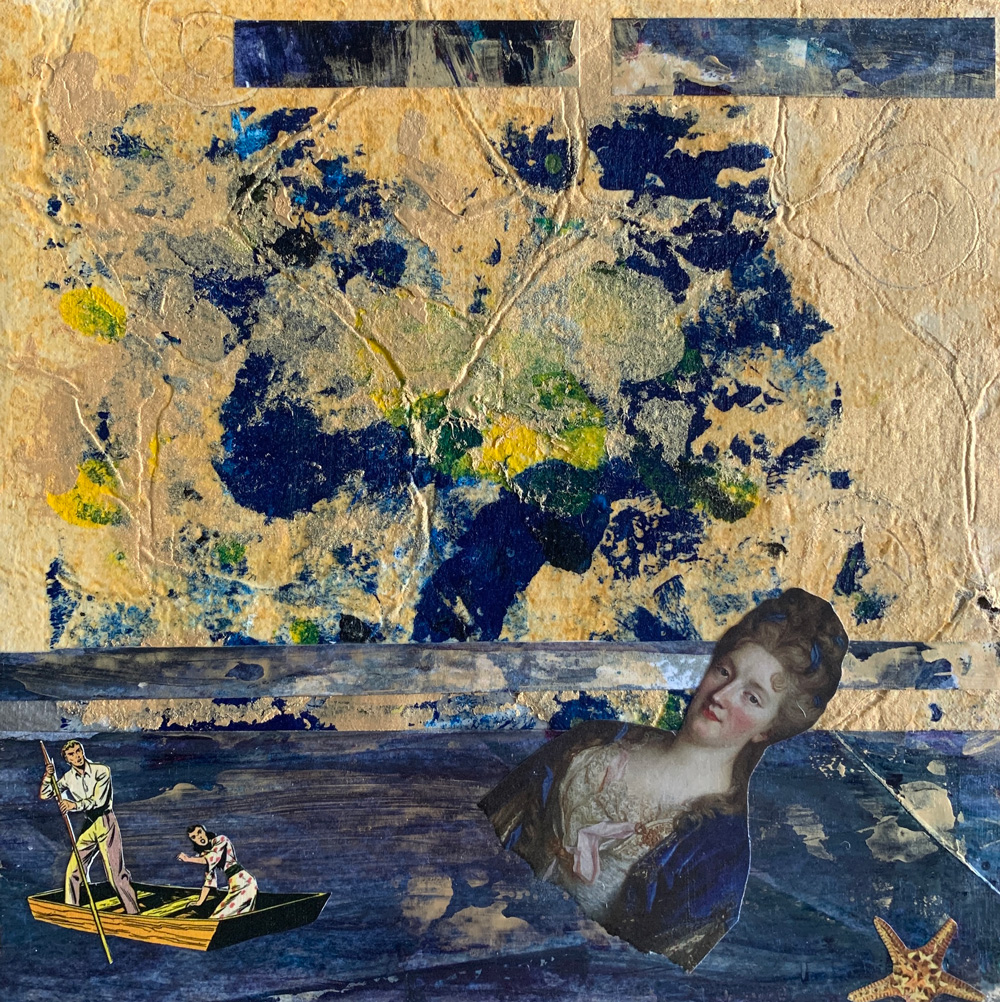
8″x8″; original gel print, paint, magazine and catalog images, classic art image; 2021. Courtesy of the artist.
Denise Emanuel Clemen has worked as an art model, an actress, an au pair in Paris, an English teacher, a merchant of her own blood plasma, an assembly-line worker in a factory, and a marine naturalist on whale watching boats. Her essays and fiction have been published in dozens of literary magazines. She has received writing fellowships to the Virginia Center for the Creative Arts, Vermont Studio Center, and the Ragdale Foundation. A visual artist since 2020, she makes collages, handmade paper, artist’s books, and decorative boxes. Denise has completed three Kolaj Institute residencies in Sanquhar, Scotland, and a residency at Casa Lü Sur in Mexico City. Her collages have been exhibited in galleries in Southern California, Pennsylvania, and New Orleans. After living most of her adult life in Los Angeles, she currently resides in Minneapolis, Minnesota, USA. Learn more at the Kolaj Magazine Artist Directory HERE.
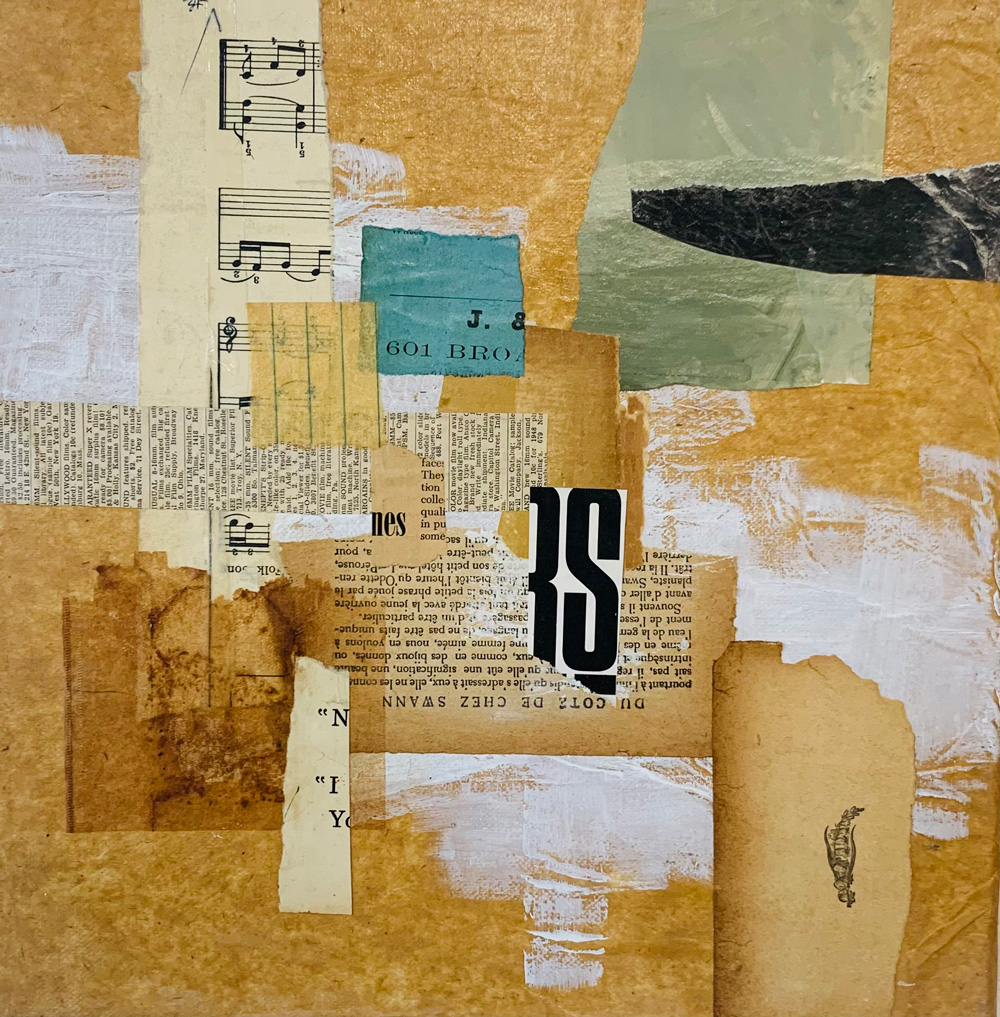
12″x12″; collage on canvas; 2015. Courtesy of the artist.
Johanna Merfeld holds a BFA from the Art Institute of Boston at Lesley University and an MA in Teaching from Tufts University/School of the Museum of Fine Arts, Boston. She is a licensed PreK-8 Visual Art educator. She is the recipient of the Maine College of Art’s Feed Your Soul Educator Fellowship and was part of ART+BIO Collaborative’s Desert Life Artist Field Study Program. She also took part in Kolaj Institute’s Collage Magic Artist Residency. Merfeld is a faculty artist at Berkshire Art Center, where she develops and leads community-based art programming for all ages. Recently, her work has been shown in three exhibitions in Western Massachusetts, USA, where she lives.
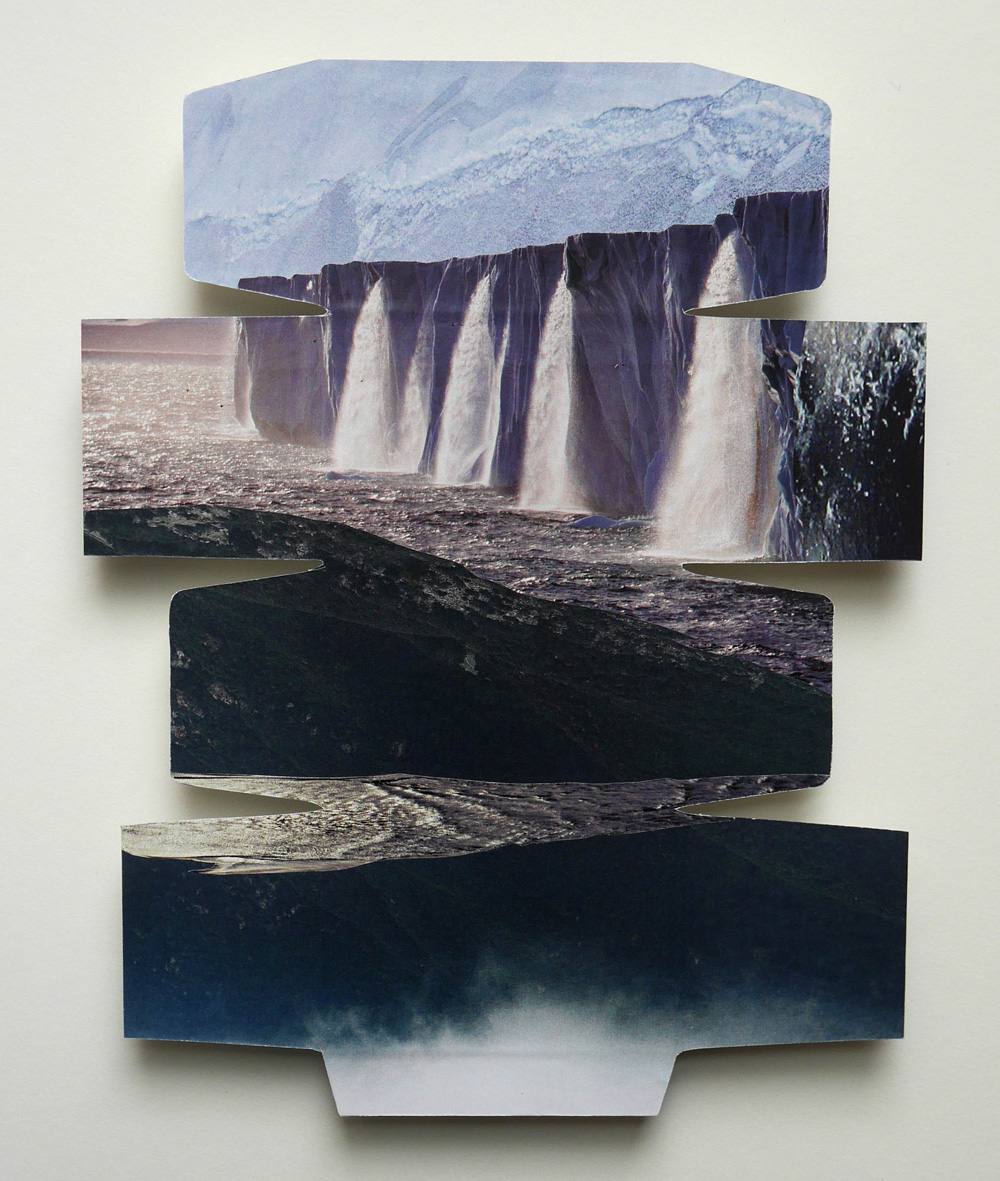
8.5″x6.625″; paper collage on ibuprofen PM box; 2025. Courtesy of the artist.
Lauren Crasco is an artist based in San Francisco and New Orleans who works throughout the United States and internationally as a Production Designer for film and television. As a designer, she focuses on the essential physical details which convey location and character in order to build an appropriate environment to reveal these specifics on camera. As a visual artist, she enjoys the freedom of creating imagined worlds which are intentionally undefined and sparsely populated. She holds a BFA from Carnegie Mellon University and studied figurative drawing and painting at Associates in Art in Sherman Oaks, California. She explores subjects including the human figure and the contemporary urban landscape through drawing, painting, and paper collage. Her work has been shown in exhibitions in Northern California, Los Angeles, and New Orleans. www.laurencrasco.com

4″x4″; paper; 2023. Courtesy of the artist.
Lindsay M. Walker is a cut&paster from Houston, Texas, USA. She’s passionate about feeling all the feelings and chasing ambiance. In between making up songs to sing to her dogs and participating in The Capitalism, she makes art. Her current hyperfocus is analog collage, but other creative passions include photography, ceramics, and pretending she’s in a musical. Learn more HERE.
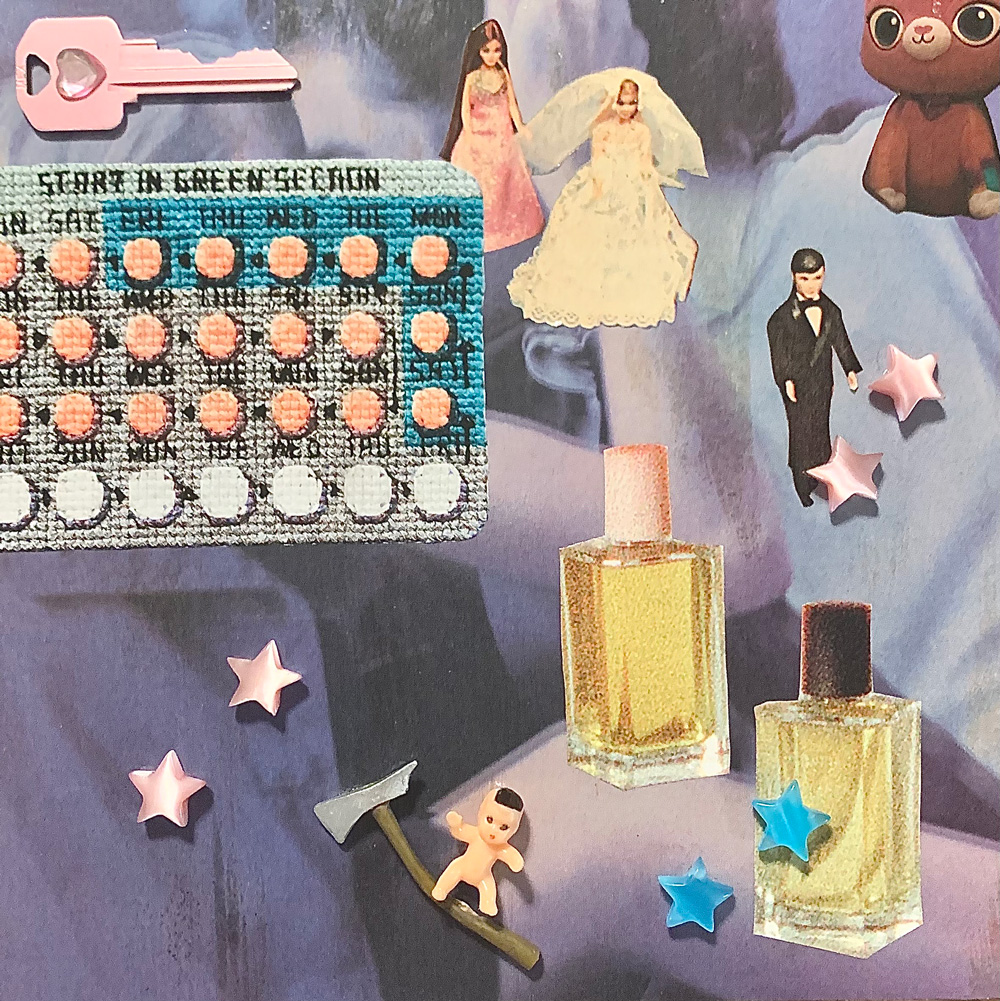
8″x8″; collage on tile; 2023. Courtesy of the artist.
Maddy Sneep is a writer and multimedia artist based in Austin, Texas, USA. Her work can be found online, in print, and most recently, in a group exhibit at Contracommon in Bee Cave, Texas, USA. While she loves traditional collage, she also enjoys attempting to stretch the boundaries of what can be considered collage. www.maddysneep.net
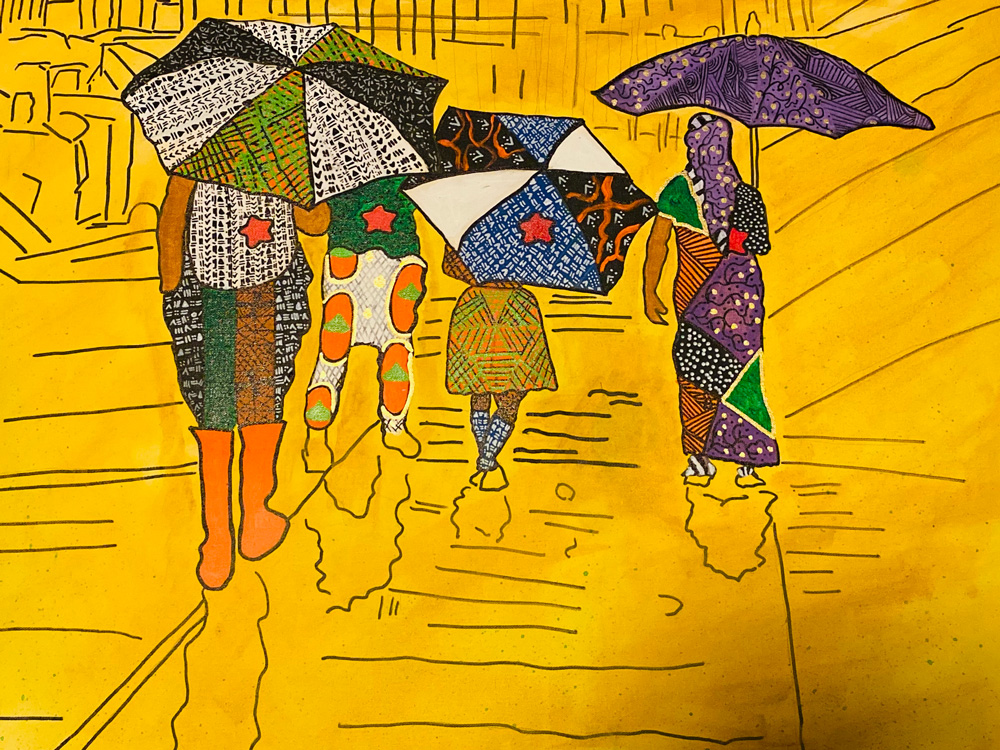
30″x40″; acrylic and pumice on canvas; 2024. Courtesy of the artist.
Taeesha Muhammad, aka Sophisticatedcookie, is a Brooklyn-bred, international artist who is always seeking opportunities to show how diverse communities are engaging in the world at large. Through this abstract, her works connect the classic and the contemporary African American, exploring the unique dynamics of life in between the lines. As an African American Woman, she feels there is a responsibility to bring attention to the glory and grace that may not be immediately evident. Since the Pandemic, she has been more contemplative with her works, and has begun to look at the relationships that people have with each other in space. The complete stoppage of the world gave a different view, leading a new voice and her work becoming richer and more embedded in the past with a contemporary canon. Her works have been featured both internationally and locally, and her practice covers canvas as well as traveling murals. As a sought after Teaching Artist, her practice has evolved into a life of creative service. Her practice has grown to include communities and people from all walks of life in her sketches. The exploration of groupings has begun to emerge. Her works have become larger in size, and bolder. Learn more HERE.
ABOUT THE FACULTY
Serving New Orleans since 1994, The Green Project‘s mission is to promote a culture of creative reuse by diverting usable materials from landfills and cultivating a respect for their value. They do this through their Salvage Store, a paint recycling program, and environmental education. By selling used items and teaching about reuse, The Green Project is able to provide affordable materials to the community, host low-cost and free workshops, keep usable goods out of the landfill and nearby waterways, preserve historic architectural pieces and educate residents about environmental issues. www.thegreenproject.org
Jill Stoll never met a medium she doesn’t like. She believes in the hand that draws, sketches, paints, collages, weaves, sews, knits, carves, prints, and releases the shutter of a (film) camera. An artist whose work transcends boundaries, she invites you to join her where each medium becomes a unique language, and every piece tells a story of ingenuity, curiosity, and a deep connection to the physical world. Jill’s making is profoundly rooted in resourcefulness, as she seeks inspiration from the overlooked abundance of materials, such as cardboard, plastic bottles, and the intriguing cat’s claw (uncaria tomentosa). Step into her studio in Arabi, Louisiana, and you’ll find yourself immersed in an environment that transcends traditional art appreciation. Her creations resonate with a multisensory experience, engaging all five senses. As a high school student under the mentorship of Lina Dean at Interlochen Arts Academy, Jill’s imagination was sparked by the intricate craft of weaving. Dean’s teachings not only imparted technical skills but also instilled a profound perspective that continues to shape Jill’s artistic worldview. Currently serving as a Professor of Practice in Design at Tulane University School of Architecture, Jill is on a continuous exploration of the systems of pattern and structure that parallels weaving drafts and pixels. Her commitment to the fusion of art and design is not just a profession but a lifelong dedication to unraveling the complexities of creative thinking. www.jillstoll.com
Ric Kasini Kadour, a 2021 Andy Warhol Foundation for the Visual Arts Curatorial Fellow, is a writer, artist, publisher, and cultural worker. Working with the Vermont Arts Council, Kadour curated four exhibits: “Connection: The Art of Coming Together” (2017) and Vermont Artists to Watch 2018, 2019 and 2020. In 2017, he curated “The Art of Winter” at S.P.A.C.E. Gallery in Burlington, Vermont. In 2018, Kadour curated “Revolutionary Paths: Critical Issues in Collage” at Antenna Gallery in New Orleans, which bought together collage artists whose work represents the potential for deeper inquiry and further curatorial exploration of the medium; followed in 2019 by “Cultural Deconstructions: Critical Issues in Collage” at LeMieux Galleries in New Orleans, which furthered the conversation; and “Amuse Bouche”, also at LeMieux Galleries in 2023. Since 2018, he has produced Kolaj Fest New Orleans, a multi-day festival & symposium about contemporary collage and its role in art, culture, and society. As Curator of Contemporary Art at Rokeby Museum in Ferrisburgh, Vermont in 2019 and 2020, he curated three exhibitions, “Rokeby Through the Lens” (May 19-June 16, 2019), “Structures” (August 24-October 27, 2019), and “Mending Fences: New Works by Carol MacDonald” (July 12-October 25, 2020). He also curated “Contemporary American Regionalism: Vermont Perspectives” (August 17-October 20, 2019); “Where the Sun Casts No Shadow: Postcards from the Creative Crossroads of Quito, Ecuador” (November 1-30, 2019); and “Many Americas” (August 20-November 27, 2022) in the Wilson Museum & Galleries at the Southern Vermont Arts Center. “The Money $how”, co-curated with Frank Juarez, was presented at the AIR Space Gallery at Saint Kate-The Arts Hotel in Milwaukee, Wisconsin (April 10-September 12, 2021). For Birr Vintage Week & Arts Festival in Birr, County Offaly, Ireland (August 13-20, 2021), he curated “Empty Columns Are a Place to Dream”, which traveled to the Knoxville Museum of Art in January-February 2022. At 516 ARTS in Albuquerque, New Mexico, Kadour co-curated with Alicia Inez Guzmàn two exhibitions: “Many Worlds Are Born” (February 19-May 14, 2022) and “Technologies of the Spirit” (June 11-September 3, 2022). In 2023 at the Knoxville Museum of Art, Kadour curated “Where the Sun Casts No Shadow: Postcards from the Creative Crossroads of Quito, Ecuador” (January 9-February 16, 2023) and “Mystical Landscape: Secrets of the Vale” (March 17-May 28, 2023). In September 2023, he curated “Word of Mouth: Folklore, Community and Collage” at A’ the Airts in Sanquhar, Scotland. At Kolaj Institute Gallery, he curated “Grand Opening Exhibition” (March 9-April 14, 2024), “Collage the Planet: Environmentalism in Art” (April 19-May 26, 2024), “Magic in the Modern World” (June 1-August 11, 2024), “Advanced Wound Healing Techniques: Collage by Robbie Morgan” (August 16-October 6, 2024), “Temporal Geolocation: How Place & History Inform Identity in Collage” (October 11-November 24, 2024), “Camera & Collage” (November 29, 2024- January 25, 2025), “Joy and Grief: An Exhibition of Collage” (April 12-May 31, 2025), and “Collage As Art Movement” (June 14-August 31, 2025).
His first short film, The Covenant of Schwitters’ Army, debuted at Collage on Screen during Kolaj Fest New Orleans 2023. His second, Joy Is Paper, debuted at Collage on Screen during Kolaj Fest New Orleans 2024. Kadour is the editor and publisher of Kolaj Magazine. He has written for a number of galleries and his writing has appeared in Hyperallergic, OEI, Vermont Magazine, Seven Days, Seattle Weekly, Art New England (where he was the former Vermont editor) and many others. Kadour maintains an active art practice and his photography, collage, and sculpture have been exhibited in and are part of private collections in Australia, Europe and North America. In January-February 2020, he was artist-in-residence at MERZ Gallery in Sanquhar, Scotland. He holds a BA in Comparative Religion from the University of Vermont. Kadour splits his time between Montreal and New Orleans. www.rickasinikadour.com
